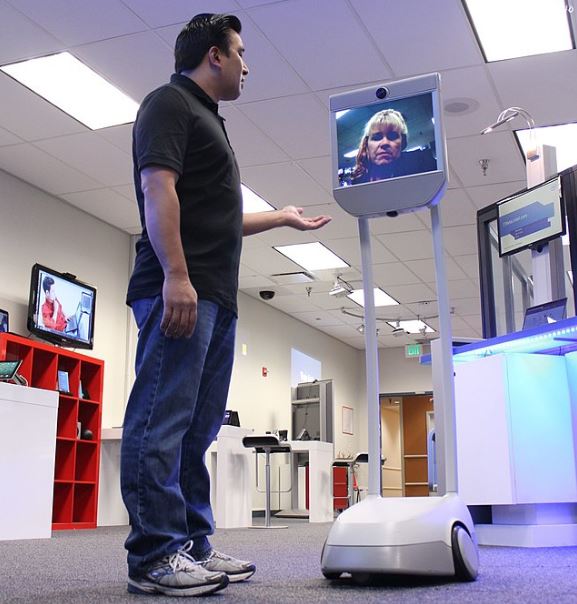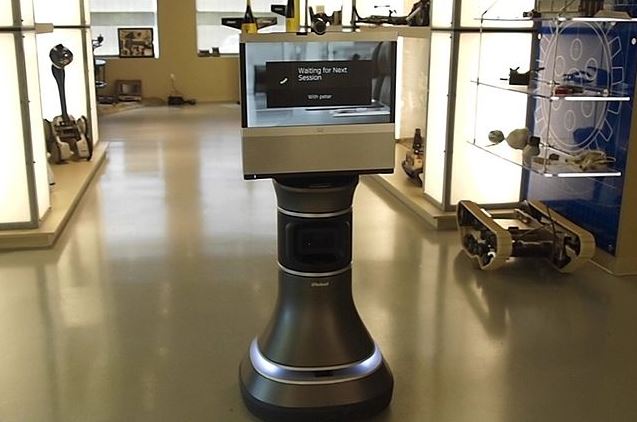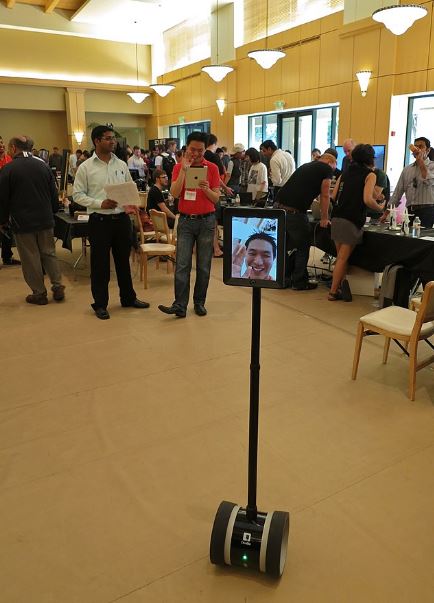A telepresence robot is a remote-controlled, wheeled device that has wireless internet connectivity. Typically, the robot uses a tablet to provide video and audio capabilities.
Telepresence robot provides a remote presence; short of touching items, you are ‘on location’ whenever and nearly wherever you wish to be.
They are also referred to as “skype on wheels.” However, telepresence robots (also known as virtual presence robots or remote presence robots) are much more.
Telepresence robots are based on two technologies: remote control and video communication.
Because of cheap high-bandwidth Internet and cheap computers with small sizes, robots on the market in a modern form factor was made possible.
Telepresence robots have become cost-effective due to the advent of WiFi, 4G/5G, WebRTC, AJAX, REST and WCF service, MQTT, powerful and at the same time cheap computer boards.
The presence of video communication system and a motion control system are enough to classify the product as a telepresence robot.
However, practice has shown that the following additional features can be useful:
-automatic docking
-obstacle detection with signalling or automatic obstacle avoidance;
-scene recognition and Autonomous movement to a given location;
-camera lens control or digital zoom using;
-remote control of the tilt of the camera.
These features are not necessary. They improve the usability of the robot, but increase its price.
Uses of Telepresence Robot
Instead of having a static view of participants (as with skype and other video conferencing applications), the controller of the robot is able to control what they wish to see, as opposed to needing someone to point a camera at a particular person
Many telepresence robots come equipped with such features as laser pointers, zoom capabilities, and autonomous driving for enhanced communication and convenience. With this total control of the robots, users can view and interact with remote environments, whether hospitals or homes for the elderly, manufacturing plants or warehouses, provided the robot is turned on and retains an internet connection, saving themselves large quantities of time, and hundreds or thousands of dollars in travel expenses.
The remote presence capabilities provided by telepresence robots enables surgeons to assist peers at different locations across the globe, business owners to view store or warehouse setups or assembly line processes, sick children to attend classes and interact with their classmates, doctors to interact with patients while not on location, and even something as simple as allowing grandparents to watch their grandchildren while they play, miles away.
Telepresence robots are commonly used to stand in for tour guides, night watchmen, factory inspectors and healthcare consultants. The rise of 5G and edge devices is powering more intelligent and versatile telepresence robots.
In a distance education class, a telepresence robot can move around the room and interact face-to-face with individual students, just as an on-premises instructor might.
In business, a telepresence robot can be used to help an employee whose disability or location prevents him from traveling still have a physical presence in the office.
In hospitals, telepresence robots provide even more robust technology to help surgeons more effectively advise their peers during an operation, physicians to more conveniently perform their rounds or monitor patients who have recently been released from the hospital, and experts to eliminate travel times in emergency situations such as the event of a stroke, when each minute saved results in the saving of millions of brain cells.
Within the medical field these robots are commonly referred to more specifically as “medical telepresence robots” or “hospital telepresence robots,” many of which have health-related applications added on to the basic telepresence capabilites.
Examples of Telepresence robots include:
Double Robotics Double 3: Consists of a wheeled base integrated with an iPad, is designed for a business environment to enhance telecommuting or teleconferencing.
Ava from Ava Robotics: Provides users with intelligent, autonomous navigation capabilities to move through large offices, event spaces and retail establishments. Embedded security features such as encryption, HTTPS management and password protection are suited to protect corporate IT infrastructure.
Vecna’s VGo: Using the VGo application, an internet-connected person located anywhere connects to a VGo device in a facility. VGo is designed to help healthcare providers deliver lower-cost services and high-quality virtual care, but has also been used by homebound students to go to school virtually.
Although telepresence robots can cost thousands of dollars, they are typically much more affordable than the travel costs or fees they might replace.
Reasons Why Telepresence is Here to Stay?
The components of telepresence are:
-Codec (also known as the video camera and controller)
-Monitor
-Microphone and Speakers
Additional components can be added, like a touchpad for ease of use, and room automation to automatically set the lights and close blinds. The additional features vary based on the specific needs of a company or organization.
Since Telepresence allows real-time, two-way collaboration between people who aren’t in the same location. They are able to speak as if they are in the same room and share data with ease. This technology allows for greater communication and collaboration, and it’s highly beneficial for businesses with multiple offices, a remote workforce, or clients in distant locations. With all the following benefits telepresence is here to stay.
Benefits:
Allows robust communication- Telepresence allows more visual collaboration so you can communicate more effectively.
Increases human inter action- Being visible reduces the likelihood of participants getting distracted or multi-tasking throughout the meeting.
Supports business enablement – Enabling business to collaborate and communicate without inconveniences is a key benefit of telepresence.
Cut down on travel- Being able to utilize communication tools and technology with telepresence can reduce time and expenses that come with traveling for meetings or presentations.
Enables fast turnaround on ROI- When you think about telepresence as a way to eliminate travel costs, increase effective communication, build engagement and provide business enablement, it’s easy to see the ROI.
What does Telepresence cost?
Each manufacturer has a different approach to Telepresence and as a result costs for one version of Telepresence can vary widely from another.
LifeSize takes a minimalist approach and their costs are among the lowest starting at about $65,000 USD per system. Polycom has the most options and features to select from and so their Telepresence systems range in price from $125,000 to $500,000 USD.Tandberg/Cisco Telepresence systems are considered among the best for video quality (configurable with a soft blue lighted background, for example) and their prices range from $350,000 to $550,000 USD per room.
Networking and content management systems that users may elect to purchase in addition to Telepresence systems may add significantly to the cost.
What to consider in the best telepresence robots?
Almost any robot is cool to have, but since you’re shelling out money, for telepresence robots, getting value for each cent is obviously important. Choosing a telepresence robot wholly depends on the function you have in mind for the telepresence robot, however, here a couple of things your choice must have.
– Great camera quality and an even better screen
– Audio
– Connectivity options
– Degree of freedom (mobility)
Little robot shop.com listed their 8 Best Telepresence Robots this include:
- Double Robotics 2-Best overall – amazing response and stability
- PadBot U1-Best value – a telepresence robot under $500
- Beam System for Remote Communications
- Temi with Alexa-Best for homes -with a growing list of applications
- KUBI Classic Telepresence Robot
- Smart Telepresence Robot for iPad Tablet
- BotEyes-Pad Telepresence Robot
- Appbot Riley Home Security Robot





